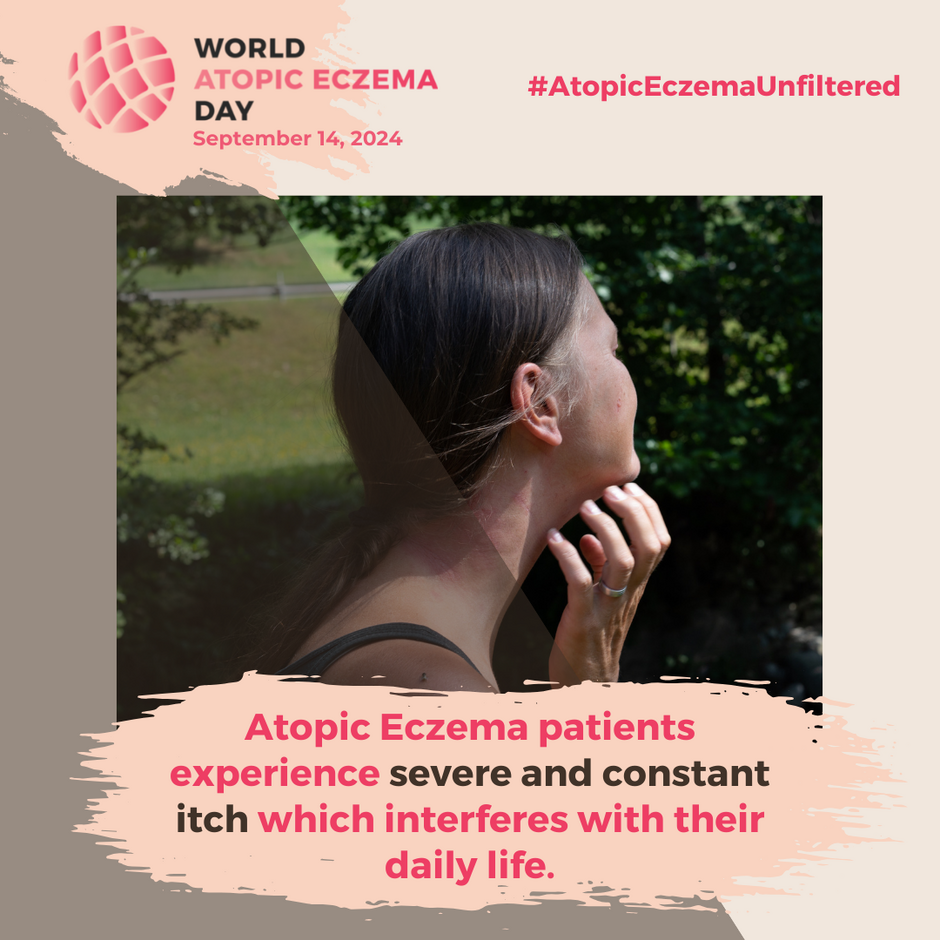
Over 230 million people worldwide are affected by atopic dermatitis (AD). That’s nearly four times more than those with psoriasis.[1],[2] So, why is one of the world’s most common inflammatory skin conditions still so hard to manage?
On September 14, 2024, we are marking World Atopic Eczema Day – an occasion to raise awareness of the condition and its real, unfiltered impact on patients. Read on to learn more, and follow along on social media using the day’s dedicated hashtag, #AtopicEczemaUnfiltered.
The burden of atopic dermatitis
Atopic dermatitis is a complex condition that can present with diverse symptoms, such as redness, painful lesions, thickened skin, scaling and intense itch. These can affect different areas of the body—including the head, neck, hands and feet—and vary in both severity and persistence.[3]
What is consistent, however, is the burden of AD – patients living with it report that the condition can have a significant negative impact on their quality of life.
Out of its range of symptoms, one stands out as particularly burdensome: nearly three-quarters of adults with moderate-to-severe AD report that itch is among their top two most problematic symptoms, alongside excessive dryness.[4]
Those living with the condition can become stuck in an itch-scratch cycle: dry skin leads to itching, causing a patient to scratch. This damages the skin barrier, leading to yet more itching.
Itch can lead to sleep disturbance that impairs a person’s functioning throughout the day. Patients with AD are also at higher risk of developing mental health disorders, such as anxiety and depression.[5],[6],[7] It can affect every moment of a person’s life – and can be frustrating and distressing for those living with the condition.
As Wendy Smith Begolka, Chief Strategy Officer of the U.S. National Eczema Association says, “We hear from the patient community all the time how all-consuming and how relentless the itch can be.”
Increasing awareness to support unmet needs
The current standard of care for AD may improve the disease’s signs and symptoms for some people, but others do not experience the same degree of relief or respond optimally to available treatments.
For some patients, even after diagnosis, viable options for managing their condition may be limited, placing the burden on them to find alternative ways to cope with their symptoms. “Patients have to figure out ways to try to deal with this in their everyday life so as to not disrupt their normal life as much as possible,” adds Wendy.
All patients deserve access to options that work for them and their unique skin needs. Achieving this requires a collective effort. Collaborations between healthcare professionals and dermatology companies are essential for truly understanding the impact of the condition, and working toward solutions that address the real challenges faced by patients.
That’s why initiatives like World Atopic Dermatitis Day are crucial; they help amplify the conversation around skin health – and ensure that every skin story is heard.
Leading progress in skin health
For more than 40 years, Galderma has been committed to driving the dermatology category forward. Our commitment to the science of skin remains underpinned by our purpose: advancing dermatology for every skin story.
Our focus remains on innovation. We are proud to work alongside the wider dermatology community to address unmet needs and educate consumers and patients about the skin they live in.
[1] Ständer S. Atopic dermatitis. N Engl J Med. 2021;384(12):1136-1143. doi:10.1056/NEJMra2023911
[2] Raharja A, et al. Psoriasis: a brief overview. Clin Med (Lond). 2021;21(3):170-173. doi: 10.7861/clinmed.2021-0257
[3] Silverberg JI. Comorbidities and the impact of atopic dermatitis. Ann Allergy Asthma Immunol. 2019;123(2):144-151. doi: 10.1016/j.anai.2019.04.020
[4] Silverberg JI, et al. Patient burden and quality of life in atopic dermatitis in US adults: a population-based cross-sectional study. Ann Allergy Asthma Immunol. 2018;121(3):340-347. doi:10.1016/j.anai.2018.07.006
[5] Langan SM, et al. Atopic dermatitis [published correction appears in Lancet. 2020;396(10253):758]. Lancet. 2020;396(10247):345-360. doi:10.1016/S0140- 6736(20)31286-1
[6] Avena-Woods C. Overview of atopic dermatitis. Am J Manag Care. 2017;23(8 suppl):S115-S123. PMID:28978208
[7] Hahn EL, Bacharier LB. The atopic march: the pattern of allergic disease development in childhood. Immunol Allergy Clin North Am. 2005;25(2):231-v. doi:10.1016/j.iac.2005.02.004